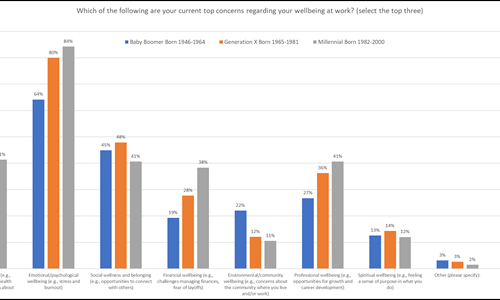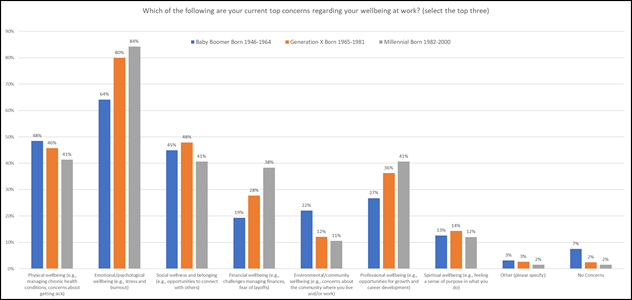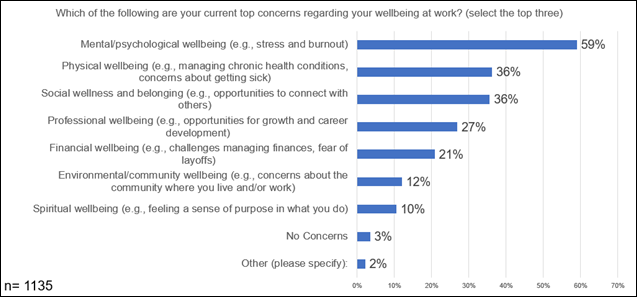4.13.21 – CI

The Conference Board survey shows participation in Employee Assistance programs has dropped, despite the struggles many workers report.
A new survey finds that U.S. workers rank mental and psychological well-being as one of their biggest wellness concerns.
Despite these worries, The Conference Board survey reveals that participation in programs including mental health resources and Employee Assistance programs has dropped. The report wasn’t broken down by industry but it’ll be interesting to see if there are numbers related to AV integration.
The nationwide survey found that most respondents continued routine doctor’s visits to some degree during the pandemic—although women struggled more.
Employees also report that they aren’t suffering in silence: An overwhelming majority feel their supervisor genuinely cares about their well-being—a likely basis for their comfort speaking of well-being challenges at work.
Conducted from early to mid-March, the online survey polled more than 1,100 US workers representing a cross-section of people across industries, from lower-level employees to the CEO.
The pandemic’s psychological toll: Workers rank mental well-being as one of their biggest concerns.
- Nearly 60 percent of workers reported concerns about stress and burnout.
- More than one-third of respondents also expressed concerns about their physical well-being, including fear of getting sick.
- Another one-third worried about social wellness and belonging, such as opportunities to connect with others.
- Spiritual well-being was of least concern, with only 10 percent reporting they were worried about feeling a sense of purpose in what they do.
CEOs’ top concerns varied greatly from those of individual contributors:
- CEOs were less concerned than lower-level employees about mental/psychological well-being:
o CEOs: 53 percent.
o Lower-level employees: 76 percent.
- But they were more concerned about financial well-being:
o CEOs: 33 percent
o Lower-level employees: 27 percent
Age and gender factored into top well-being concerns:
- Millennials are most concerned with mental and psychological well-being. As workers earlier in their careers, they are also more concerned than other generations about professional and financial well-being.
- GenXers were more concerned about social wellness and belonging than other respondents.

Inside The Conference Board Survey
Despite overwhelming concern for mental/psychological well-being, participation in programs that address these issues dropped.
- In the aggregate, usage of mental health resources and Employee Assistance Programs dropped 4 percent during the pandemic.
o Only millennials increased usage of these programs:
Millennials: +8 percent
Generation X: -5 percent
Baby Boomers: -4 percent
- Usage of online tools increased 6 percent as workers socially distanced.
o Millennials used online resources significantly more than other generations:
Millennials: +19 percent
Generation X: +4 percent
Baby Boomers: +5 percent
- Activities for social wellness and belonging, such as celebrations, retreats, and virtual coffee hours increased 4 percent.
o Women increased use of these activities, while men decreased use:
Women: +8 percent
Men: -4 percent.
- Usage of all other programs declined, with those for community well-being taking the largest hit (-25 percent).
o Men especially decreased participation in community well-being programs, compared to a lesser decrease among women.
Women: -24 percent
Men: -40 percent.

One might expect the participation among millennials in programs for career and professional well-being to be higher, given their elevated concerns about professional and financial well-being. However, usage decreased 2 percent for this population.
“With the well-being of so many workers under immense strain, it’s surprising that the use of many programs to support wellness decreased,” said Rebecca Ray, executive VP of human capital at The Conference Board.
“These findings speak to the need for better communication from leaders about the availability of resources, and a rethinking of the ways in which companies offer them,” she said.
- Baby Boomers are more concerned about physical well-being than their generational counterparts.
- Women were more concerned about spiritual well-being and slightly more concerned about physical, professional, and financial well-being than men.
- Men were slightly more concerned about social well-being than women.
An overwhelming majority (78 percent) believe their supervisor genuinely cares about their well-being.
- This supportive relationship may be why 62 percent feel comfortable speaking of their well-being challenges at work.
- Nearly one-fifth of workers (18 percent) do not feel comfortable discussing their hardships at work without fear of negative consequences.
- This includes 19 percent of women who are not comfortable, compared to 14 percent of men.
“Today more than ever, leaders need to understand their teams’ struggles so they can take steps to actively support their well-being, engagement, and productivity,” said Amy Lui Abel, VP of human capital research at The Conference Board.
“By managing with empathy, leaders can build trust and better understand how to support their employees’ well-being,” she said.
Most respondents maintained a health regimen—but CEOs and women struggled:
- Women: They had difficulty keeping up their regimen to the same degree, likely due to the disparate impact of child and elder care.
- CEOs: Executives were unable to keep up their health regimen at a higher rate than other levels, with 33 percent reporting they were unable to do what they have normally done (such as annual physicals, dental exams, and preventative tests).
- One-fifth of respondents overall were unable to maintain their regular health routine, an indicator of possible health issues in COVID-19’s aftermath.
